In Thailand, mass protests have emerged, demanding freedom from the systems of Monarchy (Sakdina) & Military Dictatorship.
To better understand the nuances of Thailand’s protests, how they connect to regional & global struggles, I was thrilled to speak to Thiti Jamkajornkeiat. Thiti has written eloquently on the protests and was kind enough to join me for an in-depth conversation.
Part 1 of our interview can be found here.
Asia Art Tours: Could you discuss how will Thai protesters insure there is no ‘18th Brumaire’ should they actually win their battle with the Monarchy? Bluntly put, if they win vs. Sakdina, how can they insure that another power structure (Global Capitalism, Right Populism, Autocratic Leftism) does not rush in to fill the sudden void of this power vacuum?
Thiti Jamkajornkeiat: In my assessment, I do not think the protestors have a clear prefigurative plan for a shadow organized structure that will assume power during the void. In the end, a democratic government, despite the most revolutionary or a working-class one, needs someone who could run it—professionally or not is up for a debate. That concern does not seem to be the protestors’ concern right now as their victories are not even within the horizon. But I think from a strategic point of view, the prevention of an 18th Brumaire and other political appropriations involves a persistent work of organizing, educating, and networking from below. Those speculations about the “evil” forces taking power aside (capitalism, Fascism, autocracy), I fear that it would rather be the moderate ideology-less political parties—the real opportunistic evil in this situation, in my opinion—that have been parasitic to the royalist and military parties will take advantage of this power vacuum, when the center-left parties or the organized bodies on the street are being oppressed and harassed.
The Thai struggle is “internal”—the monarchy-military dyad. It is almost like a patricide, or a type of cannibalism, which is complex and even painful to accept. When it comes to “internal” struggle, not least against a very venerated and deeply rooted institution at that, it is difficult to unsophisticated assign the “enemy” status to the monarchy.
 ( Thailand’s Red Shirt Protesters of 2014 were the last major political force to confront Thailand’s monarchy, military & ruling class. Systemically disbanded, arrested, killed or made ‘offers they couldn’t refuse’ they ‘re slowly reemerging to build solidarity w. Thailand’s current movement against the monarchy & junta. Read Dr. Saowanee Alexander’s excellent article for more on this topic. PHOTO CREDIT: JOSHUA ALLEN DAVIS)
( Thailand’s Red Shirt Protesters of 2014 were the last major political force to confront Thailand’s monarchy, military & ruling class. Systemically disbanded, arrested, killed or made ‘offers they couldn’t refuse’ they ‘re slowly reemerging to build solidarity w. Thailand’s current movement against the monarchy & junta. Read Dr. Saowanee Alexander’s excellent article for more on this topic. PHOTO CREDIT: JOSHUA ALLEN DAVIS)
Asia Art Tours: I’d like to turn to your article’s interrogation of the Royalist supporters of King V:
Thai intellectual historian Thongchai Winichakul has proposed hyper-royalism as the “ideological condition” of the monarchy, or, in the terminology used here, the sakdina system. Hyper-royalism denotes an exaggerated glorication of the monarchy and its excessive permeation in everyday life. . . This Thailand is the king’s nation where ratsadon are reduced to disposable bodies and mere decorations to the king’s splendid deeds. The royal-nationalist narrative, Winichakul asserts, “remains the bedrock of Thai historical consciousness.” This explains why many Thai royalists – whom this essay designates with the epithet “proud roys” – justify their counter-protests as “defending” the king’s nation and call the protestors “nation-haters” (chang chat) .
How do you compare and contrast the ‘Proud-Roys’ of a Thailand willing to use violence to defend the crown, and the ‘Proud Boys’ of the US (or other ultra-violent right wing groups) who are willing to commit violence AGAINST democracy for the benefit of figures (like Trump) who want to become Kings?
Thiti Jamkajornkeiat: I certainly have the Fascist reference in mind when I made those statements. I have been testing my ideas for some time on my own, so this is open to debate, that the Thai royalists are a species of Fascists in terms of their fanatic hyper-nationalism, xenophobia, Thai-supremacy, personality cult, a disregard of the rule of law, an assault against the “left” (in their vacuous definition), and at times religious fundamentalism. For me, the knottier point is whether royalists are all and the same with conservatives, which I think they are not, at least not in their fanaticism. In terms of class composition, a major element in the Marxist analysis of Fascism (i.e., Trotsky, Neumann, or Sweezy),
I do see great resemblances between Thai royalists and European Fascists, and even the Trumpists: a convenient class alliance between monopoly capital (sakdina)—who is treated as the leader, master, “mafia boss” or, well, king—and reactionary elements of the petty bourgeoisie or lower middle class (urbanites, bureaucrats, and military officers). The big difference, it seems, lies in the urban makeup of the Thai royalists, compared to the European and American rural Fascist demographics. Paul Sweezy points out that Fascism is a monopoly capitalist treason against liberal democratic capitalism, which I think can also be translated to the political realm as an absolute monarchical counter-revolution against liberal democracy.
I do see great resemblances between Thai royalists and European Fascists, and even the Trumpists: a convenient class alliance between monopoly capital (sakdina)—who is treated as the leader, master, “mafia boss” or, well, king—and reactionary elements of the petty bourgeoisie or lower middle class (urbanites, bureaucrats, and military officers).
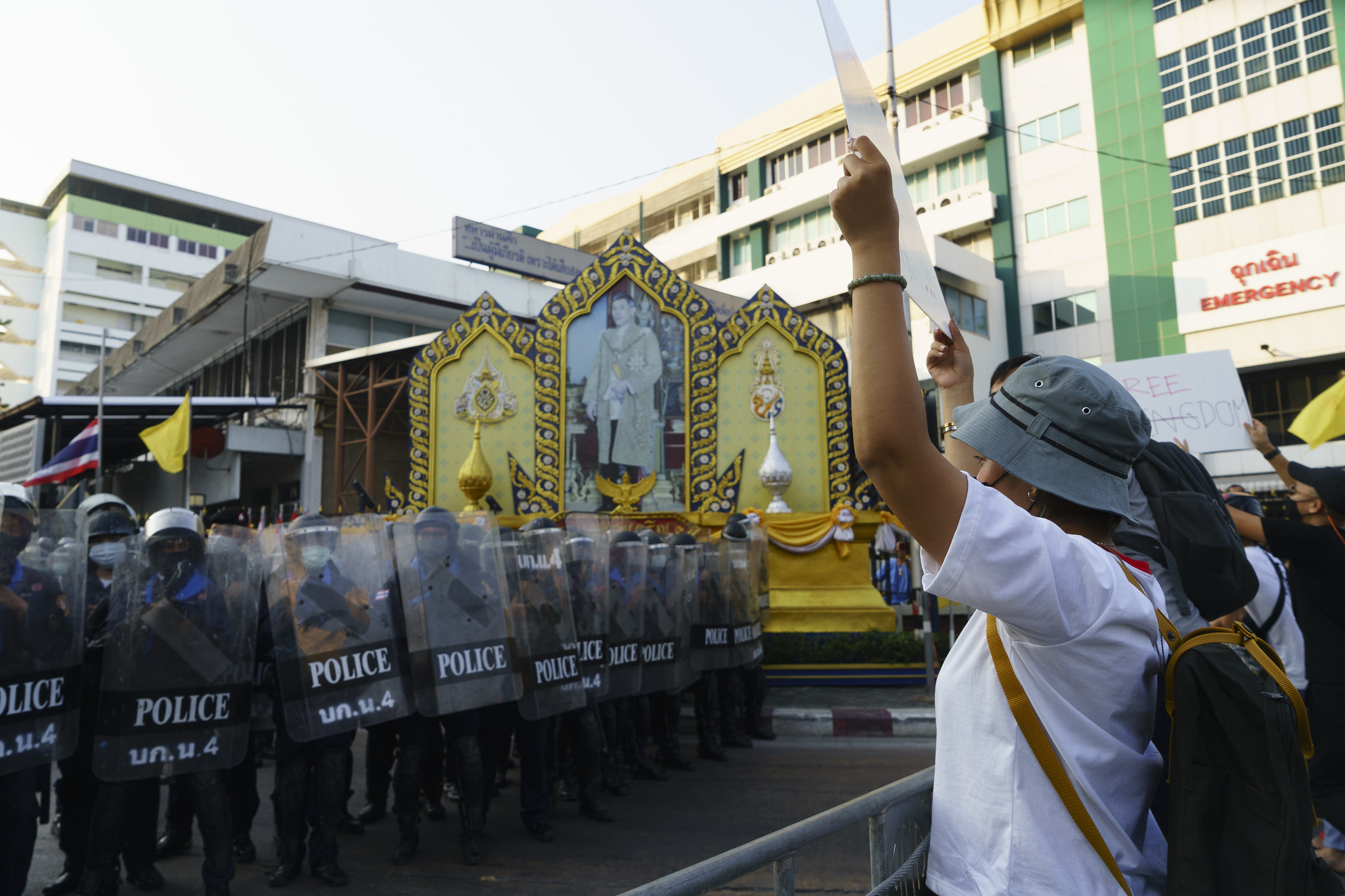 (Thai protesters face off with police in front of the Orwellian monuments to King Vajiralongkorn that one sees throughout all of Thailand in every city large and small. PHOTO CREDIT: PRACHATAI)
(Thai protesters face off with police in front of the Orwellian monuments to King Vajiralongkorn that one sees throughout all of Thailand in every city large and small. PHOTO CREDIT: PRACHATAI)
Asia Art Tours: Covid-19 has shown that under the necropolitics of modern capitalism, the mass death and suffering of ‘essential’ workers, their expendability, what makes them essential, to capitalism. Could you discuss how (if at all) Hyper-royalism compares, dialogues and contrasts with this phenomenon? And how (if at all) has Covid exposed the brutal conditions of Hyper-royalism/Sakdina to a mass audience who in the past may have remained loyal to the King?
Thiti Jamkajornkeiat: The comparison between the necropolitics of Covid capitalism and hyper-royalism is interesting but, in my opinion, might be a slightly misplaced one. This is like asking whether hardcore Trump supporters, more comparable to the royalists, would magically switch sides even when the Republican states disastrously handle Covid. They don’t, and neither do the Thai royalists. I think to really understand royalism, Fascism, or Trumpism; one needs to look at its faith, evangelical, if not fatalist, aspect—whether good or bad deeds happening, it follows the will of the transcendent. I gather that the royalist logic is operating in quite the same way, in that they won’t change sides just because they learn the brutal side of sakdina. Actually, their loyalty would prompt them to dismiss those displeasing sides as “fake news” (and they do this all the time). You see the similarities.
I think from a strategic point of view, the prevention of an 18th Brumaire and other political appropriations involves a persistent work of organizing, educating, and networking from below. Those speculations about the “evil” forces taking power aside (capitalism, Fascism, autocracy), I fear that it would rather be the moderate ideology-less political parties—the real opportunistic evil in this situation, in my opinion—that have been parasitic to the royalist and military parties will take advantage of this power vacuum, when the center-left parties or the organized bodies on the street are being oppressed and harassed.
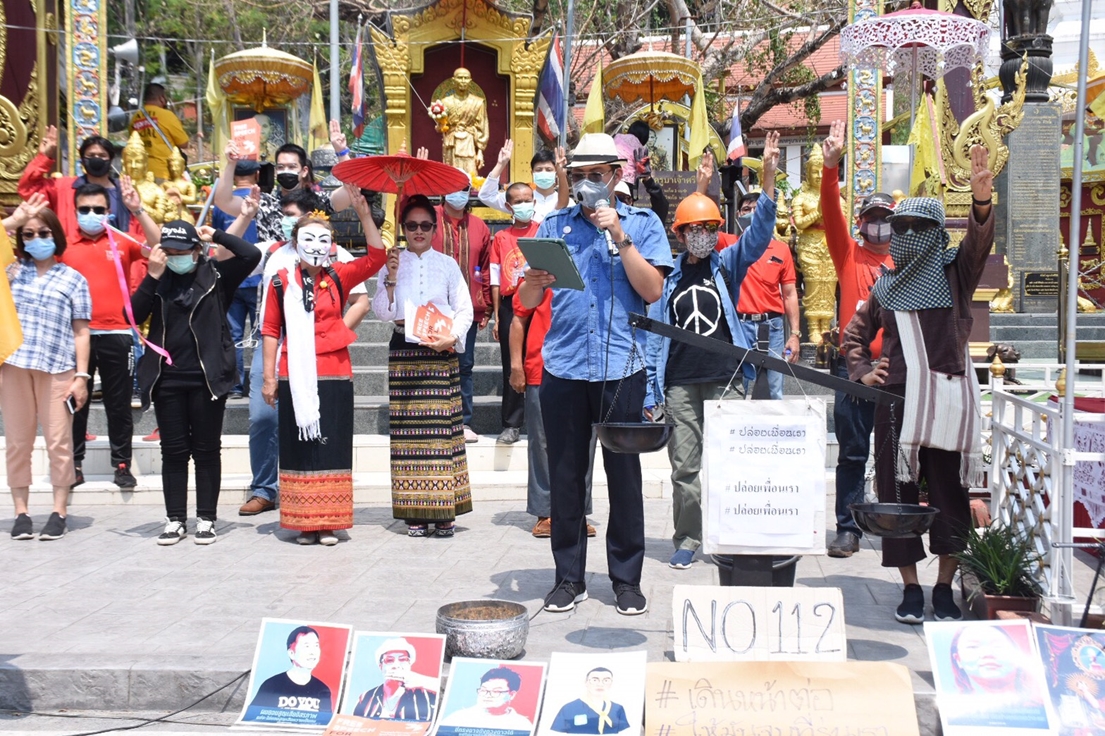 (Protesters demonstrating against Section 112 of Thailand’s criminal code, which in theory criminalizes Lèse-majesté but in practice is used as a cudgel to silence anyone who draws attention to the Monarchy’s wealth, power and parasitic relation to Thailand’s citizens. Photos in front of the protesters are of currently imprisoned activists awaiting trial for their participation in Thailand’s democracy protests. PHOTO CREDIT: PRACHATAI)
(Protesters demonstrating against Section 112 of Thailand’s criminal code, which in theory criminalizes Lèse-majesté but in practice is used as a cudgel to silence anyone who draws attention to the Monarchy’s wealth, power and parasitic relation to Thailand’s citizens. Photos in front of the protesters are of currently imprisoned activists awaiting trial for their participation in Thailand’s democracy protests. PHOTO CREDIT: PRACHATAI)
Asia Art Tours: For all these rulers who wish to rule as Monarchs, there seems to be a strong commitment to ethnonationalism and ethno-supremacy in both their vision of the sovereign and that of their supporters. Could you describe if this has also been the case in Thailand? Or with Thailand’s Buddhist majority do we see the Sakdina system use religion (rather than or in addition to Race) as a way to manifest the violence of its statecraft and its supporters?
And do you see forces like the ‘Milk-Tea Alliance’ and other trans-national movements (For BLM, Trans Rights, and Climate action as examples) as a way out of the parochial trap of nationalism or ethnonationalism that so many movements fail to overcome? If so, how might this come to fruition between Thailand’s protesters and global supporters of efforts to make Thailand’s military and monarchy again subordinate (or at least equal) to the people?
Thiti Jamkajornkeiat: As a non-specialist on the monarchy, my observation is that kingship in the nation-state era often justifies itself through the discourse of authenticity in a romantic sense, namely: an authentic yield from that nation’s soil. This authentic yield is then related to an authentic race, language, religion, and other superstructural elements in the organismic whole. It is never a surprise that most European Marxists would outright dismiss such a romantic and, when fully developed, Fascist nationalism as a bourgeois ideology or a mystification—a proposition that many third-world Marxists would rebuke by pointing to the revolutionary form of anticolonial nationalism. As Thongchai Winichakul shows, the Thai monarchs presented themselves as the protector of Thailand from foreign invasion in the official historiography, while they are de facto an internal colonizer. In short, I think the sakdina system marshals all the available superstructural resources to present itself as nationally authentic and use this claim to authenticity to establish its legitimacy.
I tend to read transnational movements as developing along a geo-historical and material basis, especially if we want to assess their real political efficacies. The problem here might be less about the parochial trap of nationalism than Thailand’s provincialism during the military government. At least in how I pessimistically see it, the monarchy-military regime has “underdeveloped” Thailand to the point that it cannot provide any added value to the transnational alliance or the “global supporters.” Thailand, in other words, is literally the globe’s surplus nation—an idea I get from the recent Marxist revival of the surplus population category—competing with other surplus nations to “race to the bottom.”
For Hong Kong and Taiwan, Thailand is a welcoming member of the Milk Tea Alliance for them because they can break out of a view that their struggles were just a Sino-sphere’s internal feud; but, what is Thailand’s function there besides an ornamental one? It is just another weak country that cannot resist both China and the US. The royal reactionary hegemony (monarchy, military, monks, Sino-Thai elites, and the cold war US) has also made the Thai political situation far from the more Manichean structure of Myanmar’s politics between bad military and good demos. In exaggerating terms, Thailand’s popular struggle may be the last to resist the Cold War era’s dictatorship. The main antagonists in the current protests have benefitted from American neocolonial order during the Cold War. The US is complicit in creating this dictatorial regime and continues to benefit from it. Washington would not do anything so disruptive, which is a sharp contrast to Biden’s rapid reaction against Myanmar’s military takeover. Indeed, it is almost pointless to say how much of the hypocrisy and irony embedded in that move (hint: more recently, bombs in Syria, or more historically, assassinations of countless civil rights and anticolonial leaders).
For Hong Kong and Taiwan, Thailand is a welcoming member of the Milk Tea Alliance because they can break out of a view that their struggles were just a Sino-sphere’s internal feud; but, what is Thailand’s function there besides an ornamental one? It is just another weak country that cannot resist both China and the US.
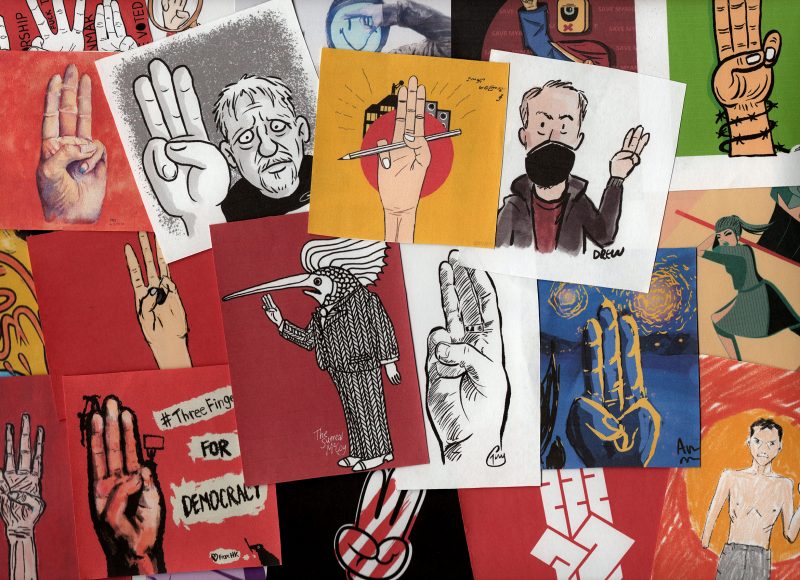 (A collage of the ‘Three Fingers’ symbol that like the symbolism of the Milk Tea Alliance has become ubiquitous in protests against dictatorship in Asia. PHOTO CREDIT: PRACHATAI)
(A collage of the ‘Three Fingers’ symbol that like the symbolism of the Milk Tea Alliance has become ubiquitous in protests against dictatorship in Asia. PHOTO CREDIT: PRACHATAI)
As much as I want to emancipate from the curses of Thai exceptionalism and provincialism—once about to be broken during the Thaksin administration—I cannot discern concrete conditions of possibility for a more substantial internationalism forged between Thai protestors and the dissidents of the world.
Another, rather wishful, possibility contributing to the protests’ success would be an internal coup within the military’s ranks and files against their commanders. Thailand used to have a robust radical tradition of revolutionary soldiers and bureaucrats, albeit elitist, siding with the people against royalism—for example, unrealized 1912 Palace Revolt’s leader Khun Thuayhanpitak or 1932 Khana Ratsadon’s tactician Phraya Songsuradet. In the current situation, which requires the broadest anti-sakdina popular front, we could no longer afford to let the scummy cops beat up and injure peaceful protesters without any protection. As Gramsci and Fanon tell us, the state would justify its monopolistic use of violence against the dissenters no matter what; maybe it is time to revive that Thai radical tradition from within the barrack and the palace, whose noncombative tendency is well-known. Of course, I never mean to neglect “the working class”—peasants and laborers—and it seems, according to Giles Ungpakorn and Lek Patchanee’s accounts, more are organizing on the ground or even planning a strike.
Though it totally warrants a fuller discussion, it might also be time to understand the current Thai protests through the abolitionist framework. Abolitionism’s demands to defund the police and obliterate prisons, along with the resonances between the legacy of slavery and the construction of Thai royalists as a form of servitude submissive to the king, might prove generative for thinking new resistant tactics and strategies.
Though it totally warrants a fuller discussion, it might also be time to understand the current Thai protests through the abolitionist framework. Abolitionism’s demands to defund the police and obliterate prisons, along with the resonances between the legacy of slavery and the construction of Thai royalists as a form of servitude submissive to the king, might prove generative for thinking new resistant tactics and strategies.
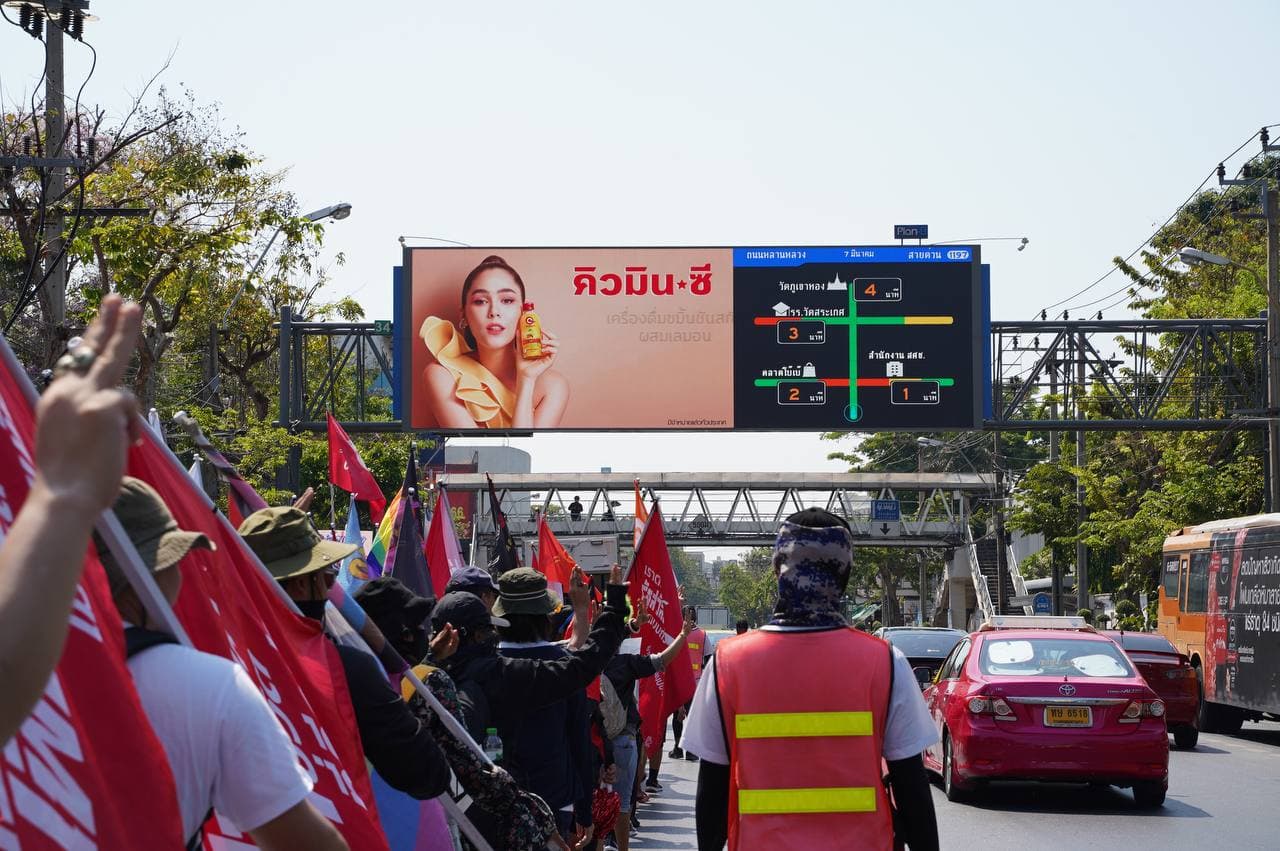 (Protesters marching down a Bangkok highway. PHOTO CREDIT: PRACHATAI)
(Protesters marching down a Bangkok highway. PHOTO CREDIT: PRACHATAI)
Asia Art Tours: And as a final coda to our conversation, turning to the brutal regime of the Tatmadaw attempting a coup in Thailand’s neighbor of Myanmar, How do you believe the recent events in Myanmar will affect Thailand’s protests?
Thiti Jamkajornkeiat: There is still so much more that I have to learn about Myanmar’s situation, but I have been following closely. The exchanges of protesting strategies and dissident symbols are inspirational. For the first time, I witness such admirable solidarity between Thai protestors and the Myanmese migrant workers—customarily treated as a subaltern and a bare life—in opposing military dictatorships. Apart from that, it is still difficult to imagine a truly positive scenario emerging as a spin-off, or a domino effect, as it were, from Myanmar’s protests. The problem with the Thai situation is that the dictators are not convinced they will lose, so they can keep staying in power.
Actually, let me end with this last note that could be both an “open secret” or a brand new terrain for researchers of Southeast Asia. I would suggest that a reason (at least) Thai dictators, both military and monarchy, are overly confident about their control and power cannot be grasped only from the realm of the visible. Some might dismiss Benedict Anderson’s classical study of wahyu, the Javanese concept of power—so believed by Suharto and his wife Ibu Tien—as a kind of cultural essentialism. Still, I think a similar phenomenon is also happening in Thailand now. Thai dictators are inordinately superstitious—here conceived as a valid kind of logic, not opposed to rationality—as they would obediently follow astrological and divine advice. As long as the dictators feel their positions are secured according to their fortunes, they could just act nonchalantly. If not, then they make some seemingly random and bizarre moves that would deflect those elements reversing their fortunes. Examples are abound, though many of these are unprovable: the preservation of Queen Suthida while appointing Sineenat as a royal consort, the removal of the Khana Ratsadon’s plaque, and more. Of course, I am not suggesting that we dismiss the political-economic analyses of the sakdina. State mechanisms, capitalist incentive, the practice of impunity, and hyper-royalism all contribute to the sakdina’s durability. Yet, I think it is an incomplete analysis if we do not take into consideration the dictators’ superstitious beliefs when we devise tactics of sedition.
I am not suggesting that we dismiss the political-economic analyses of the sakdina. State mechanisms, capitalist incentive, the practice of impunity, and hyper-royalism all contribute to the sakdina’s durability. Yet, I think it is an incomplete analysis if we do not take into consideration the dictators’ superstitious beliefs when we devise tactics of sedition.
 (A protester in Thailand, holds a photo of Myanmar democracy protesters carrying an injured citizen as they run from the Tatmadaw, Myanmar’s viciously brutal military junta. PHOTO CREDIT: PRACHATAI)
(A protester in Thailand, holds a photo of Myanmar democracy protesters carrying an injured citizen as they run from the Tatmadaw, Myanmar’s viciously brutal military junta. PHOTO CREDIT: PRACHATAI)
You (Matt, Asia Art Tours) reached out to interview me since early January, which I have postponed until now because I have been occupied with completing one of my dissertation chapters. By going through the materials for this chapter, I have nonetheless discovered a gem from Fidel Castro’s closing speech for the 1966 Tricontinental Conference that I wish to share with you all, comrades, skipping the more controversial part:
The duty of every revolutionary is to effect the revolution, and effect it in deed, not in word; not be a revolutionary in theory alone, but a revolutionary in practice—if revolutionaries spend less energy and time on theorizing and devote more energy and time to practical work … then the hour of liberation for this continent will be advanced. … What with the ones who theorize, and the ones who criticize those who theorize while beginning to theorize themselves, much energy and time is unfortunately lost.
Dialectically, after a long contemplative and silent period of theorizing, now is THE time for revolutionary practice! The last sentence is dedicated to every Thai, particularly non-royalist moderates and non-radical liberals, to stop wasting energy and time on criticism and more on practical work! It is either a transition to ratsadon’s nation or regression into sakdina’s barbarism!
Dialectically, after a long contemplative and silent period of theorizing, now is THE time for revolutionary practice! The last sentence is dedicated to every Thai, particularly non-royalist moderates and non-radical liberals, to stop wasting energy and time on criticism and more on practical work! It is either a transition to ratsadon’s nation or regression into sakdina’s barbarism!
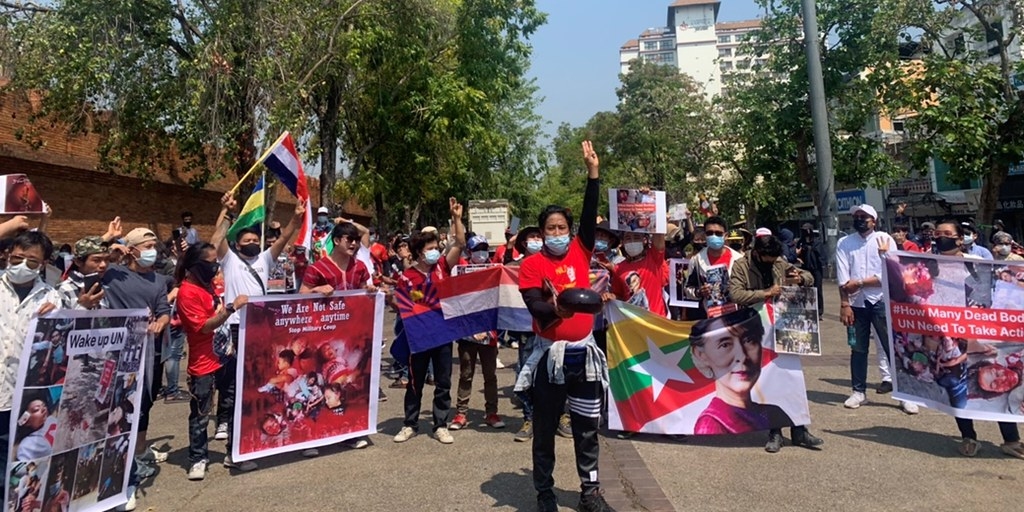 (Protesters in Thailand holding a solidarity protest for protesters in Myanmar. PHOTO CREDIT:PRACHATAI)
(Protesters in Thailand holding a solidarity protest for protesters in Myanmar. PHOTO CREDIT:PRACHATAI)
Part 1 of our conversation with Thiti Jamkajornkeiat can be found here. For more w. Thiti, you can read his wonderful essay on Spectre.
